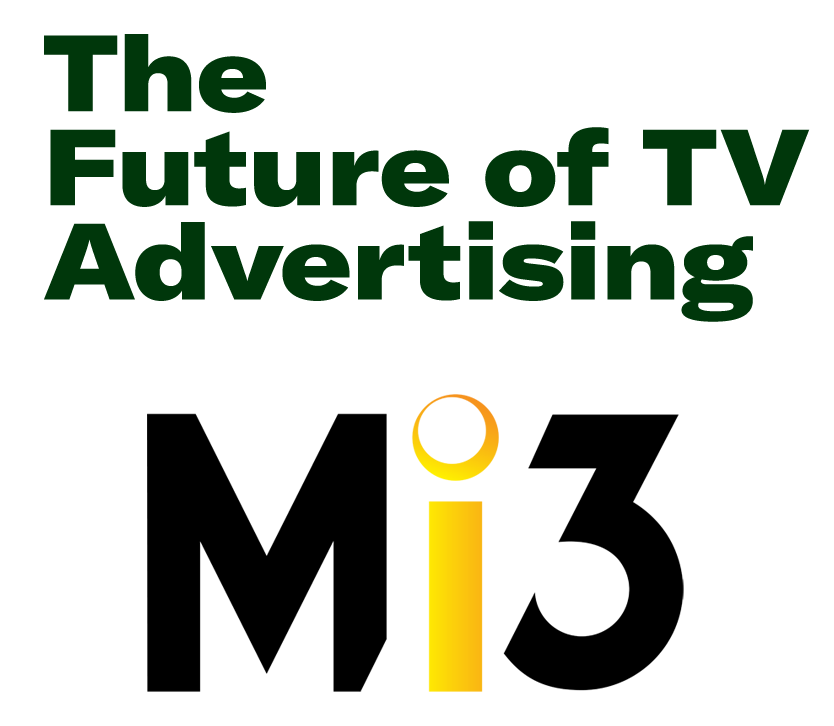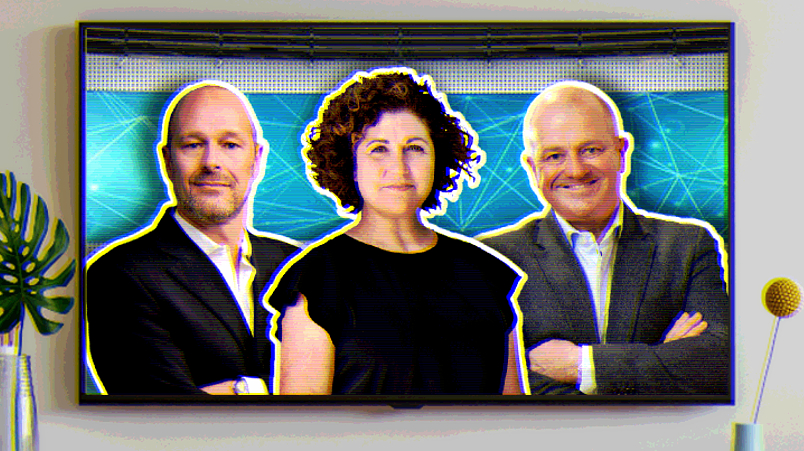CMOs on TV, BVOD v Netflix ad tier: Tourism Australia shifts budget from CX to brand, media; Hipages back on TV but mid-funnel content new priority; Pet Circle calls for a unified BVOD marketplace
An Mi3 editorial series brought to you by
The Future of TV Advertising Forum and Mi3


L-R: Pet Circle's Jon Wild, Tourism Australia's Susan Coghill and Hipages' Stuart Tucker
An Mi3 editorial series brought to you by
The Future of TV Advertising Forum and Mi3

Marketers are open to hiving off a portion of budgets into streaming platforms now pushing ad tiers but there are some pretty weighty caveats – they want greater scale, lower prices, integration, faster data feedback – and self-serve capability. In the final wrap from the Future of TV Advertising forum last month, Tourism Australia CMO Susan Coghill, Hipages Chief Customer Officer Stuart Tucker and Pet Circle CMO Jon Wild signal their intent.
What you need to know:
- Terrestrial TV audiences might be diving but Hipages Chief Customer Officer Stuart Tucker says it still delivers the tradie marketplace its most important customer segment – over 45s. "I'm not sure if anyone under 45 in Australia can afford a property anymore," per Tucker.
- Tourism Australia CMO Susan Coghill has diverted circa 20 per cent of her budget out of CX and martech back to brand investment to compete in the consideration battle for Brand Australia against other global tourism destinations: "High yielding travellers ... aren’t necessarily living on a government tourism website,” says Coghill.
- Jon Wild, CMO at Pet Circle, a VC-backed top five online Australian ecom pure-play with 500,000-plus customers and revenues upwards of $400m, handles most of its media in-house and is frustrated by the absence of a unified trading platform for broadcast video on demand [BVOD]. "I'm sure Shopify could just about run a TV marketplace," he says.
Linear audiences might be down 20 per cent, but as far as I'm concerned it's making it up one for one on BVOD, and I'm okay with that.
Hipages Chief Customer Officer Stuart Tucker said none of the platform’s circa $15m budget currently goes to Netflix or Binge ads. Instead, he’s still backing free-to-air TV, with Hipages onboard to sponsor The Block for a fifth year. While other marketers and agency execs are vocal about the challenge of make-goods – i.e. networks making up for free-to-air audience shortfalls, often with BVOD inventory – Tucker is sanguine.
“Linear or BVOD, it's still a viewer. As long as it's a good piece of creative that is meeting the right viewer, then I'm cool with it,” said Tucker. “Linear audiences might be down 20 per cent, but as far as I'm concerned it's making it up one for one on BVOD, and I'm okay with that.”
Streamers: integrate to win…
But Tucker thinks the next financial year could present a “tipping point”. Hipages will likely “dabble” in ad-funded streaming services to connect with the buy-side of its two-sided marketplace – homeowners.
“Our traditional homeowner audience on the consumer side, 45-plus [years old] is still in those traditional channels [i.e. free to air]. I’m not sure if anyone under 45 in Australia can afford a property anymore,” said Tucker.
“But we also have an emerging market [under 45s] and their viewing consumption is different. So we … will have to play… in that emerging market while still protecting [investment in] the traditional market [i.e. linear TV and BVOD]. We can’t ignore [streaming] completely, but we’re just going to tread lightly.”
Tourism Australia CMO Susan Coghill takes a similar view – TA needs scale, and in Western markets the target audience, higher yielding travellers, “do tend to be a bit older, so being on linear TV that maybe skews a bit older still works for us,” she said.
Alongside greater scale, Coghill said the streamers would stand a better chance of landing TA ad dollars by packaging advertiser integration and sponsorships.
“We tend to be at our best with broadcast partners when we can integrate with them,” said Coghill. “If we start to see innovation from some of those streaming platforms with paid advertising models, that starts to become much more interesting and compelling.”
The notion of a marketplace is so simple, so many companies have done it. I don't quite understand why the industry hasn't embraced that kind of technology. I'm sure Shopify could just about run a TV marketplace.
… and go self-serve
Pet Circle CMO Jon Wild said the firm is keen to tap younger audiences, but the likes of Netflix “are expensive at the moment. When you stack them up against alternatives, it’s hard to get the paybacks.”
Payback periods are under sustained pressure at VC-backed firms after the easy growth-at-all-cost money dried up last year. Wild said he is now tasked with delivering ROI on customer acquisition costs within 12 months, versus 24 months a year ago, which means scrutinising every spot, dot and media investment across the piste.
While Pet Circle will test the ad-funded streaming market, Wild suggested platforms that launch self-serve options would attract a greater share of spend.
“We buy most of our digital media [in-house]. So if I could buy directly and test, that would be more attractive to me.
Faster reporting required
Given increased ROI pressure, Wild’s biggest gripe around linear TV is a lack of instant reporting and optimisation. He also blasted the networks for not getting their act together on a unified buying platform. While Nine, Ten and Seven have ambitions to launch a collective BVOD marketplace, it is not entirely clear what will be presented to market, and when.
Wild is perplexed. “The notion of a marketplace is so simple, so many companies have done it. I don't quite understand why the industry hasn't embraced that kind of technology,” said Wild. “I'm sure Shopify could just about run a TV marketplace.”
High yielding [international] travellers ... aren’t necessarily living on a government tourism website. If we don't win in consideration [for brand Australia v other destinations], we don't win anywhere else through our customer journey.
Tourism Australia: Reallocating CX budgets into brand
After a major focus on its website, content and back-end capability over the last two years, Tourism Australia is now diverting upwards of 20 per cent of CX budgets back into paid media in a push to refill the funnel. Coghill lead TA’s global $125m ad blitz for brand Australian last October in a textbook marketing strategy which worked distinctive assets, animated characters and animated characters. In System1’s global benchmarks for effective creative, TA’s efforts were the most effective on record for any brand.
“We have an amazing website where we've invested a lot in over the last couple of years, both in terms of content and functionality … But for the next two to three years, while we focus on rebuilding and recovery, we have to talk to those high yielding travellers – and they aren’t necessarily living on a government tourism website,” said Coghill.
Meanwhile, with other markets “coming out swinging” after Covid, “not least of which the Middle East, which has very deep pockets”, it’s harder to cut through. Which means spending more. And while TAs circa $140m budget might sound huge, “they aren’t when you divide them by 15 or so international markets, and add in media inflation, it gets pretty tricky,” said Coghill. “But if we don't win in consideration, we don't win anywhere else through our customer journey.”
Hipages: mid-funnel next battleground
Last year tradies didn’t need to advertise. Business was booming. But as rate rises have literally hit home, and homeowners have tightened their belts, that’s all changed.
“We've been overwhelmed by inquiry onto our platform, by tradies, literally since the 1 January,” said Hipages’ Tucker. Now it’s case of trying to balance up the two-sided marketplace.
“On the homeowner side, we're an infrequent purchase. You might need between four and seven tradies a year in your house. So we just need to maintain top line awareness and then be there when they're ready to buy,” said Tucker. Hence re-signing with The Block – because the impact on other media channels over the long-term has proven that it works.
“Unlike Jon [Wild, Pet Circle’s CMO], we’re not running an ecommerce platform, so I don’t have to prove a return on every spot,” said Tucker.
“If it's driving positive brand metrics around awareness, consideration, and preference, and it's driving our key commercial metrics around jobs and trade inquiry, then I'm okay with it. We could disappear up our [wazoo] trying to analyse every single spot. I'd rather take a long-term view – and then it pays off. The bottom line is that if no one's ever heard of you and they don't have an emotional affiliation with you, they won't buy from you,” said Tucker.
And it is paying off.
“When I joined the company [in 2017], I was a bit horrified that we were sitting at 27 per cent prompted awareness. We’ve lifted that to 66 per cent in five years.”
Likewise, the long-term brand investment has had a major impact on Hipages’ performance strategy and spend.
“When I joined, the percentage of jobs that came from search was 55 per cent and now it's 16 per cent. So we've actually proven the value of investing in brand over time. We now are way less dependent on paid search and we use it strategically to balance the marketplace: If we need a few more jobs in Sydney or we need electricians in Adelaide, we can act on that pretty fast,” said Tucker.
“So we’ve worked out the top of the funnel and the bottom – and now we are focusing on the mid-funnel, particularly on the tradie side. We’re building awareness, but they are not always ready to buy,” he added. “Their business conditions change, their category dynamics change, sometimes there's seasonality. So how can we create a digital and content-led funnel that takes intent or maybe turns a suspect into a prospect and then into a customer? So we're working hard on an inbound marketing program right now that fills that gap in the middle, specifically for tradies.”
That’s a content and tech play, said Tucker, which he said would be “effective by next quarter”.
Funnel vision
Pet Circle’s Jon Wild said the firm is also seeing “pretty strong correlation between media effectiveness and our performance and consideration, and that is giving us some confidence to reinvest in the top of the funnel.”
Is that shifting twitchy VC thinking around strict 12-month ROI demands on marketing investment and customer acquisition?
“We’re shifting them,” said Wild. “It’s a process.”
